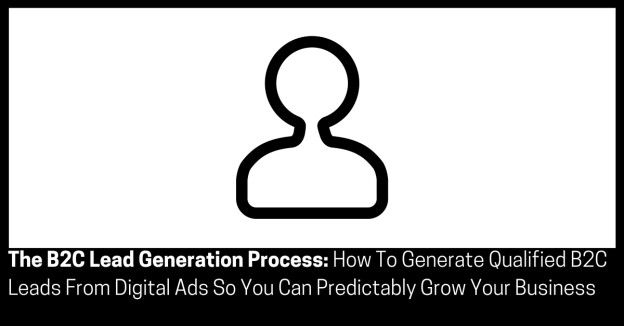Approximate read time: 7 minutes
Generating qualified B2C leads from digital ads so you can predictably grow your business, involves two steps.
Here they are:
- STEP 1: Advertisements; and
- STEP 2: Lead Pages.
Let’s now turn to exploring them in greater detail…
Before we begin, let’s look at the economics of what is possible with B2C lead generation.
Let’s say it costs you $40 to acquire a qualified lead (a lead that has shown interest) to an opt-in offer at $2 CPC, with the ad converting at CTR of 2% and the lead converting at CTR of 5%.
This means 1,000 ad views will generate 20 ad clicks and one lead page opt-in.
If you are able to double the CTR of the ad and double the CTR of the landing page, that is, from 2% to 4% and 5% to 10% respectively, it costs you $20 to acquire a qualified lead to an opt-in offer at $2 CPC, with the ad converting at CTR of 4% and the lead converting at CTR of 10%.
This means 1,000 ad views will generate 40 ad clicks and four lead page opt-ins.
Effectively, you have dropped the qualified lead acquisition cost by double, or $20 per qualified lead, saving you $20 per lead.
Instead of costing you say $100 to acquire that sale, it now only costs you $50.
Imagine what that could do for your business.
Without further ado, let’s begin with…

1) Advertisements
The first step is about ads, creating them, testing them and measuring their performance.
I purposely didn’t choose the words “designing ads,” as I didn’t want to get confused with design.
Design can be important, but what is critical is that you create two separate ads using the following formula also known as the acronym, AIDA:
- (A)ttention;
- (I)nterest;
- (D)esire; and
- (A)ction.
The term and format are attributed to Elias St. Elmo Lewis.
When discussing advertising, Lewis said, “The mission of an advertisement is to attract a reader, so that he will look at the advertisement and start to read it; then to interest him, so that he will continue to read it; then to convince him, so that when he has read it he will believe it. If an advertisement contains these three qualities of success, it is a successful advertisement.”
This is what they mean:
- You first need to attract prospects’ or customers’ attention, cut through and stand out among all the other communication they are receiving;
- You then need to engage prospects or customers so they listen to your message;
- You then need to help them convince themselves that they desire your offer; and
- You finally need them to act on that desire.
Of course, the exact details of how to do this are beyond the scope of this guide.
These should take into account digital ad best practice, that is, stating the:
- Brand creation story;
- Brand credibility;
- Value proposition;
- Features;
- Benefits;
- Advantage;
- Who it is for and not for;
- The offer;
- The price;
- That value translated into other currencies;
- Guarantees;
- Bonuses and incentives;
- Testimonials and case studies;
- Call to action;
- And so on…
This formula is consistent across text, image or video ads no matter the platform.
Speaking of platforms, some digital ad categories and larger digital ad platforms include:
- Search Engine Marketing (Google Adwords, Bing ads, Yahoo ads);
- Social Media Marketing (Facebook ads, LinkedIn ads, Instagram ads, Twitter ads, Pinterest ads, YouTube TrueView, Stumble Upon Paid Discovery); and
- Content Marketing (Outbrain, Taboola).
Next, load credit into these platforms and turn on the ads to start showing impressions.
After running the ads for a little while, measure which of the two ads you created performed best in sending traffic to your lead page via the digital ad platform’s analytics.
These will be based on:
- Ad views or impressions;
- Ad clicks to the lead page;
- Ad click-through-ratio (CTR) to the lead page. This is the number of clicks to how many people saw the ad. A better CTR means cheaper clicks because it is relevant to the users; and
- Cost-per-click (CPC).
Keep the best performing ad and discard the worst performing ad out of the original two.
Next, create another ad based on the best performing ad, but only change one element, such as the headline.
Run this new ad with the previous best performing ad.
This is called split testing.
Repeat this process indefinitely to find the very best performing ad.
The factors (in priority order) to test should be the:
- Headline;
- Image/video/text; and
- Call to action.
After you are statistically confident that you have the best performing ad, purchase display ads through an “ad buy.”
Display ads are usually expensive to buy (you buy them in 100,000s of impressions), and it is near impossible to micro-test them for the best performing ad because display ad platforms usually do not have that capability.
Of course, the exact details of how to do this are beyond the scope of this guide.
In summary, this step is about creating, testing and measuring performance of ads.
This leads us to the next step, the Lead Page…

2) Lead Pages
…Step 2 is about creating, testing and measuring performance of lead pages.
A landing page is a web page that is the first point of contact for a visitor.
A lead page is a landing page that is designed to segment and qualify a prospect.
This could be:
- Content with an embedded opt-in offer (say in the form of a blog post); or
- A sales squeeze page with an opt-in offer.
In parallel with creating and testing digital ads, you should design two separate lead pages that again follow the same AIDA process as above.
Once two separate lead pages are created, it is time to upload them to your website server and test them.
After having these lead pages live, measure which of the two lead pages you created performed best via Google Analytics in sending prospects to your post opt-in page, based on:
- Visitors to the landing page (this should align with ad clicks to the lead page in the above step);
- Clicks to the post opt-in page; and
- Click-through-ratio (CTR) to the post opt-in page.
Keep the best performing lead page, and discard the worst performing lead page out of the original two.
Next, create another lead page based on the best performing lead page, but only change one element such as the headline.
Run this new lead page with the previous best performing lead page.
This is called split testing.
Repeat the process indefinitely to find the very best performing lead page.
Again, the factors (in priority order) you should test are:
- Headline;
- Image/video/text; and
- Call to action.
Of those visitors who bounce (exit) from the page, purchase remarketing ads to send them back to the same lead pages.
Speaking of remarketing platforms, some large one include:
- Google Display Network; and
- Facebook Custom Audiences.
Of course, the exact details of how to do this are beyond the scope of this guide.
In summary, this step is about creating, testing and measuring the performance of lead pages.

Take Action
You made it…
You now have a solid plan for B2C Lead Generation.
That’s the full B2C Lead Generation Process, and it will be more than enough for you to get started on your own.
You can get the printed illustrated Process Map of this and 20 others for free, here
And if you’re serious about marketing and selling more, the logical next step is to contact me to help you do it yourself, have me do it with you, or have it all done for you.
This maybe the momentum you need to get great marketing and sales results.
Now let’s learn about The Search Engine Optimization Process.
Or do you simply want more like this?
Join below to be notified immediately about new content and more. No annoying daily emails and no spam – just good content when it’s posted.

